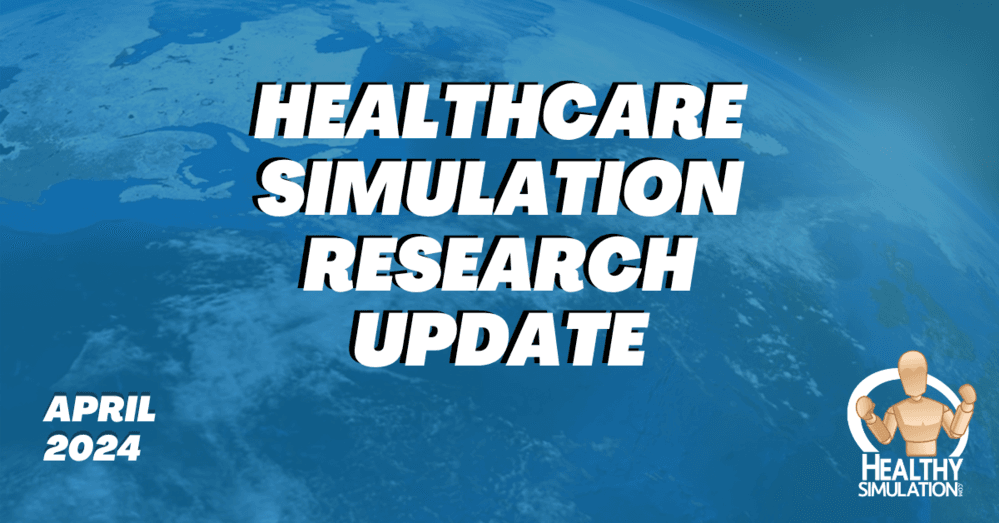Healthcare Simulation Research Update April 2024
The field of healthcare simulation has made tremendous strides over the past several decades. One way this revolution is made possible is through clinical simulation research being conducted globally. Multiple peer-reviewed journals focus on clinical simulation research. Simulationists should keep up-to-date on the latest research findings and evidence by reading and evaluating clinical simulation journals. This HealthySimulation.com article by Content Manager Teresa Gore, PhD, DNP, APRN, FNP-BC, CHSE-A, FSSH, FAAN, provides an overview of the latest clinical simulation highlights as of April 2024 and explains how these updates impact the healthcare simulation community overall.
Emergency airway management in the prone position: an observational mannequin-based simulation study : Accidental extubation during a prone position can be a life-threatening emergency requiring the rapid establishment of the airway. However, there is limited evidence of the best airway rescue method for this potentially catastrophic emergency. The aim of this study was to determine the most effective method to recover the airway in case of accidental extubation during prone positioning by comparing three techniques: supraglottic airway device (SAD), video laryngoscopy (CMAC), and fiber-optic bronchoscopy (FOB) in a simulated environment.
Eleven anesthesiologists and 12 anesthesia fellows performed the simulated airway management using three different techniques on a mannequin positioned prone in head pins. Time required for definitive airway management and the success rates were measured. The results of this simulation-based study suggest that the SAD I-gel is the best technique to manage accidental extubation during prone position by establishing a temporary airway with excellent success rate and shorter procedure time. When comparing techniques for securing a definitive airway, the FOB was more successful than the CMAC.
Sponsored Content:
Assessing the equivalency of face-to-face and online simulated patient interviews in an educational intervention : This paper reports on a multi-methods research project comparing in-person and online simulated patient interviews conducted by allied health professionals as part of an educational intervention offered at a large university teaching hospital.
Twenty-three participants conducted two 15-minute interviews with simulated patients using previously validated scenarios of patients presenting with suicide risk. In order to assess the equivalency of the two modalities, physiological and psychological stress were measured using heart rate variability parameters and the State-Trait Anxiety Inventory respectively, and then were compared across cohorts using t-tests. These findings provide developing evidence that carefully designed online clinical simulations can be a useful tool for the education and assessment of healthcare professionals.
View the LEARN CE/CME Platform Webinar How to Conduct Effective Research on Healthcare Simulation-Based Educational Interventions to learn more!
Using a Delphi Method Approach to Select Theoretical Underpinnings of Crowdsourcing and Rank Their Application to a Crowdsourcing App : This project aimed to develop the theoretical foundations of a crowdsourcing Web-based application (Web app) to fill the gap in health professions simulation training equipment via community-based 3D printing. We aimed to discover how to effectively leverage crowdsourcing with local 3D printers and use these resources to produce simulators via this Web app accessed through computers or smart devices.
Sponsored Content:
First, a scoping literature review was conducted to discover the theoretical underpinnings of crowdsourcing. Second, these review results were ranked by consumer (health field) and producer (3D printing field) groups via modified Delphi method surveys to determine suitable community engagement strategies for the Web app. Third, the results informed different app iteration ideas and were then generalized beyond the app to address scenarios entailing environmental changes and demands.
A scoping review revealed eight crowdsourcing-related theories. Three were deemed most suitable for our context by both participant groups: Motivation Crowding Theory, Social Exchange Theory, and Transaction Cost Theory. Each theory proposed a different crowdsourcing solution that can streamline additive manufacturing within simulation while applicable to multiple contexts. Results will be aggregated to develop this flexible Web app that adapts to stakeholder needs and ultimately solves this gap by delivering home-based simulation via community mobilization.
The Effects of Reflective Pauses on Performance in Simulation Training : The reflective pause, taking a pause during performance to reflect, is an important practice in simulation-based learning. However, for novice learners, it is a highly complex self-regulatory skill that cannot stand alone without guidance. Using educational theories, we propose how to design cognitive and metacognitive aids to guide learners with the reflective pause and investigate its effects on performance in a simulation training environment.
These effects are examined in four aspects of performance: cognitive load, primary performance, secondary performance, and encapsulation. Medical students (N = 72) performed tasks in simulation training for emergency medicine, under two conditions: reflection condition (n = 36), where reflection was prompted and guided, and control condition (n = 36) without such reflection. The effects of reflective pauses emerged for two aspects of performance: cognitive load decreased, and secondary performance improved. However, primary performance and encapsulation did not show significant difference.
Stress Testing the Cardiac Catheterization Laboratory: A Novel Use of In Situ Simulation to Identify and Mitigate Latent Safety Threats During Acute Airway Management : Although uncommon, cardiac arrests in the cardiac catheterization laboratory (CCL) are often catastrophic and likely to increase with rising case complexity. In situ simulation (ISS) has been used to identify latent safety threats (LSTs) in inpatient units but has not yet to be studied in the CCL.
Three Plan-Do-Study-Act (PDSA) cycles leveraging ISS were conducted focused on acute airway management. Data collected through debriefs focused on (1) airway management, (2) equipment availability, and (3) interdepartmental communication. The LSTs were subcategorized and plotted on the Survey Analysis for Evaluating Risk (SAFER)-Matrix. A SAFER score was calculated based on quantifying the likelihood of harm, scope, and the number of times a threat was identified during simulation. Time to definitive airway was collected as a secondary measure. Interventions were developed using cause and effect and driver diagrams between PDSA cycles. This study successfully leveraged ISS and existing quality improvement initiatives in the CCL, which resulted in a decrease in airway-related threats as measured through simulation.
Transforming Professional Identity in Simulation Debriefing: A Systematic Metaethnographic Synthesis of the Simulation Literature : There continues to be a lack of detailed understanding of how debriefing works and how it enables learning. To further our understanding and simultaneously illuminate current knowledge, a metaethnographic qualitative synthesis was undertaken to address the research question: how are interactions in simulation debriefing related to participant learning? Ten databases were searched (up to November 2020) and 17 articles were selected for inclusion.
Initial interpretive synthesis generated 37 new concepts that were further synthesized to produce a new theoretical framework. At the heart of the framework is a concept of reflective work, where participants and faculty recontextualize the simulation experience bidirectionally with clinical reality: a process that facilitates sensemaking. This occurs in a learning milieu where activities such as storytelling, performance evaluation, perspective sharing, agenda setting, and video use are undertaken. The outcome is conceptualization of new future roles, clinical competence, and professional language development—a process of transforming professional identity.
More About Medical Simulation Research
Medical Simulation has emerged as a professional field within healthcare education, training, and patient safety. Healthcare Simulation Research Journals have paved the way for academic exploration, understanding, and evolution of the modern day methodology with numerous unique moving parts including: scenario development, debriefing, facilitation, technology, operations, learning theories, and more. A list of available medical simulation journals and healthcare simulation research publications available from around the world is available on HealthySimulation.com. Those looking for longer reads should check out our Healthcare Simulation Books page!
Learn More About Healthcare Simulation Research Journals!
Teresa Gore, PhD, DNP, APRN, FNP-BC, CHSE-A, FSSH, FAAN – Dr. Gore has experience in educating future nurses in the undergraduate and graduate nursing programs. Dr. Gore has a PhD in Adult Education, a DNP as a family nurse practitioner, and a certificate in Simulation Education. Dr. Gore is an innovative, compassionate educator and an expert in the field of healthcare simulation. In 2007l Teresa started her journey in healthcare simulation. She is involved in INACSL and SSH. She is a Past-President of INACSL and is a Certified Healthcare Simulation Educator Advanced (CHSE-A). In 2018, she was inducted as a Fellow in the American Academy of Nursing (FAAN). In 2021, she was inducted as a Fellow in the Society of Simulation in Healthcare Academy (FSSH) and selected as a Visionary Leader University of Alabama at Birmingham School of Nursing Alumni. During her career, Dr. Gore has led in the development and integration of simulation into all undergraduate clinical courses and started an OSCE program for APRN students. Her research interests and scholarly work focus on simulation, online course development and faculty development. She has numerous invited presentations nationally and internationally on simulation topics.
Sponsored Content:


















